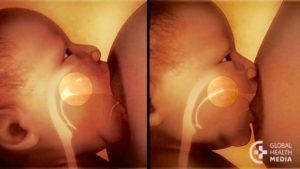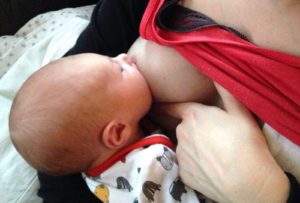What can you do yourself when breastfeeding a tongue tied baby?
 Start by paying extra attention to the latch. This sometimes means that cutting the tongue tie is not necessary.
Start by paying extra attention to the latch. This sometimes means that cutting the tongue tie is not necessary.
But even when treatment is done, it is important to exercise the tongue (muscles) and to offer more grip. 'Snipping' the tongue tie alone is usually not the solution in my experience.
What is important is that the baby needs more grip and shape of the breast to be able to take enough areola in the mouth. Pay particular attention to support a deeper latch underneath, so to focus on positioning of the lower jaw.
Tips (and accompanying videos!):
- Provide an 'asymmetric' and as large as possible latch; more from the bottom of your areola than from the top. See the video “Sandwich Hold / Asymmetrical”.
- Try a position where the baby looks slightly up, chin more touching the breast than the nose. More vertical feeding positioning can help. Take a look at the Mamma Minds Method.
 Keep the breast supported at the level of the lower jaw, as if you are flattening the breast.
Keep the breast supported at the level of the lower jaw, as if you are flattening the breast.- This is also known as the 'Concorde' position. This works even better if you position the baby as vertically as possible and keep him/her close to you by supporting the back with your forearm. With the support of your finger(s) under the breast, you will see that your nipple moves a little more downwards to the tongue and friction is less against the palate (which causes pain). The baby can also often take larger swallows.
- See the video of my colleague Myrte - Concorde and Concorde Explanation (pdf)
- Also, a good explanation from my colleague in Australia (the Milk Meg) 'Koala Hold'
- Seek out guidance if feeding is painful and too much effort...
Tongue tie and complaints when feeding
 The tongue tie under the baby's tongue may be a bit tighter or may be attached to the tongue in a way that prevents the tongue from moving optimally. To be able to drink properly from the breast, it is important that the tongue can move freely and that the lower jaw wall is covered by the tongue while drinking. If it isn’t, it sometimes feels like biting or pinching, and the nipple can come out flat. A (too) short tongue tie generally gives more often complaints than a (too) short lip tie. Hence first I will share information about the tongue tie.
The tongue tie under the baby's tongue may be a bit tighter or may be attached to the tongue in a way that prevents the tongue from moving optimally. To be able to drink properly from the breast, it is important that the tongue can move freely and that the lower jaw wall is covered by the tongue while drinking. If it isn’t, it sometimes feels like biting or pinching, and the nipple can come out flat. A (too) short tongue tie generally gives more often complaints than a (too) short lip tie. Hence first I will share information about the tongue tie.
The following complaints may be related to a tongue tie or lip tie (to a lesser extent)
- (Persisting) pain when feeding at the breast
- Flattened and tender nipples after feeding ('lipstick shape'). Over time, nipples can become painfully white/purple due to the clamping ('Secondary Raynaud's' complaints)
- Insufficient or decreased growth (from childbirth, but also sometimes after a few months)
- Long feeds: drinking takes more effort, the baby pulls on the nipple while drinking, or cannot take enough of the breast in its mouth
- Persistent difficulties with a strong milk flow, or let-down reflex
- Reduced milk flow
- (Repeatedly) blocked ducts and/or breast inflammation, insufficient emptying of the breast
- Reflux complaints (e.g., by being able to create less vacuum, resulting in a greater intake of air, and difficulty swallowing)
- Insufficient vacuum with the breast or bottle (clacking sound, milk leaking, long feedings)
This often causes (long-term) discomfort when feeding, so that the total duration of the feed is often shorter than you would like.
In short, these are valid reasons to see if the tongue tie is indeed restricting.
I will perform an oral examination, observe the feeding and then give specific advice about positioning. If necessary, I will use the aspects of the Hazelbaker Score to assess the function and characteristics of the tongue. I will inform you so you can decide what’s best for you. I will also give specific advice about postures and aftercare exercises.
Different Types of Tongue-Ties

Mondonderzoek tongriem Mamma Minds
Everyone has a tongue tie (frenulum) and tongue ties come in many anatomical appearances. Some are designed in such a way that result in a more limited movement of the tongue.
A tongue tie that is attached to the tip of the tongue ('front' or 'anterior') clearly reduces freedom of movement. You will often see a notch or dent at the tip of the tongue (heart-shaped or like a 'leaf'). But a tongue tie can also consist of stiffer tissue (thick, lnon-elastic, instead of a thin membrane) and cause restriction more at the back of the floor of the mouth ('posterior'). Sometimes the tongue tie is not (easily) visible and if it is hidden behind the oral mucosa that it is called a 'hidden' tongue tie.
Types/Classification Tongue Tie Restriction
Underneath a discription of the 4 types of restrictive tongue ties in terms of anatomical appearance. The classification by Dr. Kotlow is widely used for this. The figures say nothing about the 'severity’ but describe the place of attachment.

Ook zo benieuwd naar de plaatjes? Ik kom ze graag toelichten...
Appearance and Functional Features of the Tongue Tie
It is not only about how the tongue and the tongue tie look (appearance), but also about what the tongue can do functionally. It is, after all, a muscle. This can be assessed with the Hazelbaker Score. This score gives points for the optimal and less optimal appearance and functional characteristics. The score can give direction to the decision on whether or not to cut. The fewer points, the more the restriction.
What shape is the breast/nipple?
As important as the tongue tie is the shape of the breast and the nipple. If a breast is easier to form and offers grip, and/or if there is sufficient production, a tighter tongue tie may be less of a problem. Every situation is different. Positioning can be adjusted, and latching optimilised. This can improve the situation and sometimes makes 'treatment' unnessicary. That is why in my opnionion it is so important that the situation is first looked at carefully and thoroughly.


